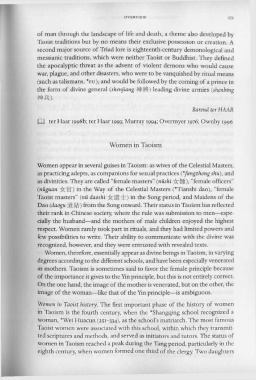Page 211 - The Encyclopedia of Taoism v1_A-L
P. 211
OV ERVI EW 171
of man through the landscape of life and death, a theme also developed by
Taoist traditions but by no means their exclusive possession or creation. A
econd major source of Triad lore is eighteenth-century demonological and
messianic traditIons, which were neither Taoist or Buddhist. They defined
the apocalyptic threat as the advent of violent demons who would cause
war, plague, and other disasters, who were to be vanquished by ritual means
(such as talismans, *FU), and would be followed by the coming of a prince in
the form of divine general (shenjiang ;fill ~) leading divine armies (shenbing
;f$~).
Barend ter HAAR
m ter Haar I998b; ter Haar I993; Murray I994; Overmyer I976; Ownby I996
Women in Taoism
Women appear in several guises in Taoism: as wives of the Celestial Masters,
as practicing adepts, as companions for sexual practices (*Jangzhong shu), and
as divinities. They are called "female masters" (nushi '!l:. gjP). "female officers"
(nuguan '!l:.'§) in the Way of the Celestial Masters (*Tianshi dao), "female
Taoist masters" (nu daoshi '!l:.-@:±) in the Song period, and Maidens of the
Dao (daogu -@:p~) from the Song onward. Their status in Taoism has reflected
their rank in Chinese society, where the rule was submission to men-espe-
cially the husband-and the mothers of male children enjoyed the highest
respect. Women rarely took part in rituals, and they had limited powers and
few possibilities to write. Their ability to communicate with the divine was
recognized, however, and they were entrusted with revealed texts.
Women, therefore, essentially appear as divine beings in Taoism, in varying
degrees according to the different schools, and have been especially venerated
as mothers. Taoism is sometimes said to favor the female principle because
of the importance it gives to the Yin principle, but this is not entirely correct.
On the one hand, the image of the mother is venerated, but on the other, the
image of the woman-like that of the Yin principle- is ambiguous.
Women in Taoist history. The first important phase of the history of women
in Taoism is the fourth century, when the *Shangqing school recognized a
woman, *Wei Huacun (25I-334), as the school's matriarch. The most famous
Taoist women were associated with this school, within which they transmit-
ted scriptures and methods, and served as initiators and tutors. The status of
women in Taoism reached a peak during the Tang period, particularly in the
eighth century, when women formed one third of the clergy. Two daughters

